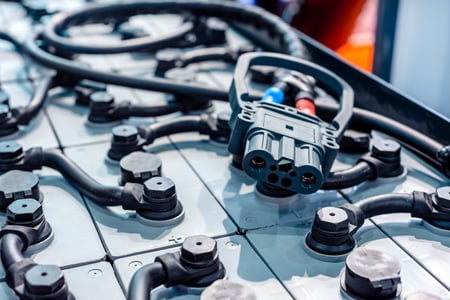 To keep your manufacturing and distribution supply chain as productive and efficient as possible, you should make sure you're optimizing every area and system within your facility. This means focusing on processes you may have overlooked, such as your forklift battery watering system.
To keep your manufacturing and distribution supply chain as productive and efficient as possible, you should make sure you're optimizing every area and system within your facility. This means focusing on processes you may have overlooked, such as your forklift battery watering system.
While forklift battery watering may appear to be too niche an area to have a significant impact on your operations, it can become a productivity bottleneck if not attended to carefully. After all, if your powered vehicles' batteries are not being watered to the correct levels, the functionality and usable lifespan of this expensive equipment may be suffering.
Whether you're investing in new hardware or implementing watering as one aspect of a more overarching power-as-a-service offering, an upgrade to your forklift battery watering system can quietly revolutionize the production you get from your forklift fleet.
The importance of having the right forklift battery watering system
Many companies overlook forklift battery watering. This is not because they are negligent, necessarily. They simply have a system that appears to be working and they stay with it, year after year. What these organizations are really doing, however, is overlooking an opportunity to drive extra productivity and value.
The weaknesses of inconsistent or inefficient lead acid battery watering can add up over time. These solutions can even decrease the usable lifespan of batteries by one to three years. Considering the capital expense associated with buying new battery hardware, this has immense repercussions on the bottom line.
It's easy for employees to lose track of battery watering if there is no clear and optimized system in place. These workers' main duties don't have anything to do with batteries, and they spend most of their time taking care of their primary objectives.
Implementing a more successful approach to forklift battery watering means being intentional about when and how batteries are watered, integrating monitoring and charging processes into a holistic battery management approach. This type of effort can keep forklifts running with less downtime while also maximizing usable lifespan and total cost of ownership.
6 factors for a successful forklift battery watering system
Putting together a more effective forklift battery filling system doesn't have to be an overly complex or intimidating process. Your organization can start to get a handle on its industrial battery watering needs by considering the following six points:
1. Maintain the correct water levels
How precisely are your personnel tracking the levels of water within batteries? To optimize the performance and usable life of each battery cell, they should be paying close attention. If the water level in a battery is below the plates when that battery is charging, those plates can overheat and dry out, which will reduce the battery's usable lifespan.
The exact level of water in a battery should be roughly one quarter-inch above the plates. Filling to this level instead of completely topping off the battery keeps the plates from overheating while also stopping short of creating an acid leak, which may also shorten battery lifespan.
2. Water batteries after charging
While it's important to have the proper level of water in a battery, it's also vital to add the water at the right time. Charging changes the water level in a battery in two ways — through fluid expansion and evaporation due to heat buildup.
If personnel water batteries before a charge, they may accidentally fill them higher than the required level. This, in turn, could cause an overflow, unbalance the cell's electrolyte level and shorten the usable life of the battery.
3. Periodically make random pilot cell checks
If your organization uses an effective single point watering system to keep electrolyte levels consistently correct, it could be tempting to become complacent, assuming batteries are always properly watered. It's important to make checks, however, to ensure that the fluid is indeed one quarter-inch below the vent after watering and above the element protector post-charge.
What's a good inspection frequency? Checking two to three pilot cells approximately once every five charges, coupled with monthly inspections, should give you a good amount of data on how your watering system is performing.
4. Make sure personnel understand battery science
The scientific principles behind forklift power may not seem very relevant, as long as the system is generally working. However, your team is much better equipped to keep up with battery watering, charging and monitoring if they understand why they are performing specific inspection and maintenance processes.
Employees trained to understand electrolyte levels, voltages and the effects of gravity can be certain whether the current approach to watering is successful and make changes if they detect issues. Having people on hand who understand battery science ensures best practices aren't simply being followed by rote.
5. Have a watering schedule and plan
The best way to make sure watering is happening in the right way and at the correct frequency is to create a regular schedule. The default is to water once every one to three weeks, though this won't apply in all situations. The type of use you're getting from your electric forklift fleet will impact the ideal schedule, as will the temperature of your work environment.
Creating a solid watering plan and monitoring schedule can ensure all batteries get watered, not just those on hand when employees act. Having a schedule also helps personnel water decisively and efficiently. The four main goals of scheduling are safety, performance, extended lifespan and lower total cost of ownership.
6. Perform periodic maintenance
In addition to more frequent water level checks and overall monitoring of batteries, watering should also be one of the factors considered in your organization's periodic maintenance strategy. Depending on the scale and velocity of your operations, checks may occur annually, semi-annually or quarterly.
Technicians should check that water levels are consistent before washing and servicing batteries, checking specific gravity and checking voltages. Ensuring all cells are operating at peak efficiency is an important part of general forklift battery upkeep.
A forklift battery watering system as part of GuaranteedPOWER® forklift power service
While you can focus on creating an ideal battery watering system as part of an in-house power management process, there is another option. When you sign a contract for a power-as-a-service solution such as GuaranteedPOWER® service, all battery management tasks are taken over by expert technicians, including battery watering.
Forklift battery management strategies created as part of GuaranteedPOWER® service contracts are designed to be closely aligned with overall supply chain strategies. This means the number and type of batteries are specifically calculated to match your needs, and processes such as forklift battery maintenance, battery watering and charging are carried out to ensure a minimum of downtime.
The cost model associated with a power management program is different from the traditional option of buying hardware. All capital expenditures are replaced with a predictable monthly cost structure, which can be 30% lower than with the standard model. This is an especially useful option for fast-moving facilities using 10 or more forklifts.
Whether you choose to embrace the GuaranteedPOWER® service model and turn your battery operations over to third-party experts or you opt for a system managed in house, one fact remains true: You should make sure your forklift battery watering system is a fully optimized process rather than an afterthought. Your logistics efficiency as a whole may depend on this decision.
Contact Concentric today to see if your facility qualifies for a free power and operational assessment.


 Ryan Lynch
Ryan Lynch
